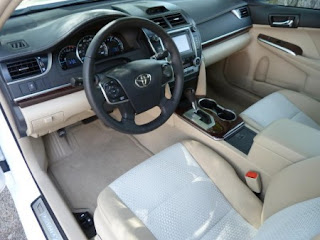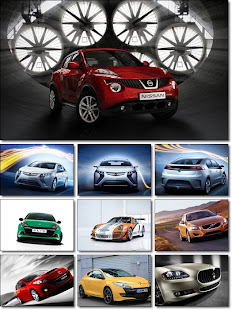But with competitors more stylish, more powerful, better-finished, and even poised to pass the Camry in refinement, the Camry increasingly trades on past accolades, incentives, and a reputation for reliability. Consequently, younger drivers go elsewhere, and the average buyer has hit the big 6-0. Many have bought their last car. To maintain its leadership, the Camry must improve. With the 2012 redesign, does it? (This review covers the regular Camry. The SE and Hybrid will be evaluated separately.)
Time was, Toyota entirely revised its cars every other generation. But the 2012 Camry is the third generation on a platform that dates back to the 2002 model year. Exterior dimensions are unchanged, and interior dimensions increase by only fractions of an inch. Consequently, the Camry remains considerably smaller than the Honda Accord, the Mazda6, and even the new Volkswagen Passat. But many buyers have rejected the Honda and Mazda as too large; for them the Camry was already the right size.
Toyota notes that every exterior panel is new. At first glance the midsection looks much the same, though a closer study discovers simpler surfacing. The ends of the car have changed more dramatically, giving up their Banglesque curves for boxier shapes. Neither striking nor laden with controversial flourishes, the new exterior recalls the Camrys of the 1980s and 1990s in its utterly forgettable inoffensiveness.
Criticisms of the 2007-2011 interior clearly hit home, for Toyota has upgraded the Camry’s cabin for 2012. The instrument panel top has stitching in a contrasting color molded into it (a technique also employed by Buick and Lincoln), some other surfaces are somewhat soft to the touch, the instruments have a more sophisticated appearance, and the doors feel more solid when opened and closed. Though plenty of hard plastic lingers, the thin velour seat fabrics verge on chintzy even in the XLE, and the “stitching” molded into the trim pieces flanking the lower center stack (why?) could not be less convincing, the overall effect is a substantial step in the right direction. Not class-leading, but solidly average. The hard plastics feel solid and none of the switches feels cheap. The controls are easy to reach and generally intuitive.
The seating position and perceived roominess of the Camry have changed much more than the minimally changed interior dimensions suggest. The base of the side windows and especially that of the windshield seem higher and more distant. Part of this is real, but the interior panels have also been reshaped to provide the appearance of a roomier interior, with more horizontal lines, sharper corners where the doors and instrument panel meet, and fewer intrusive curves. The seats also seem to have been repositioned. The downside: forward visibility takes a modest hit in the front row and a more sizable one in the second row.
About those front seats: they’re larger and less contoured. Better for regular patrons of Old Country Buffet, less supportive for the rest of us. In the LE, the non-adjustable lumbar support is lacking, with a small bulge high up the seatback. The power lumbar in the XLE helps, but also hits a little high. The rear seat, perhaps the segment’s roomiest a decade ago, can’t match those in the Honda and VW for limo-like legroom and sits a little low. Rear air vents are only fitted with the XLE. Trunk room is much more competitive.
With an intense focus on what car buyers are willing and unwilling to pay for, Toyota has carried over last year’s 178-horsepower 2.5-liter four-cylinder and 268-horspower 3.5-liter V6 engines. Meaning no direct injection, but the Hyundai Sonata and Kia Optima are the outliers here. Everyone else is in the same ballpark with their fours. Others’ uplevel engines kick out just a few more horses—is there an industry-wide gentleman’s agreement to limit midsize sedan buyers to 275 horsepower? Paired as before with a six-speed automatic, even the four is easily quick enough for most drivers. The manual transmission has been dropped, but the automatic is manually-shiftable in all non-Hybrid Camrys. The four’s shakiness at idle and buzziness when revved are larger issues. Winding the four out gets the job done, but is more irritating than exciting. Those seeking a smoother, much better-sounding engine should, as before, opt for the six.
Car buyers have put a higher priority on fuel economy than horsepower in recent years, and Toyota focused its efforts accordingly. Toyota cut curb weights (by 117 pounds for the four, 63 for the V6), smoothed the underbody, thinned the oil, raised the final drive ratios, fitted electric-assist power steering, and so forth to pick up a few tenths here, a few tenths there. The end result: EPA ratings of 25 city / 35 highway for the four, up from 22/32 last year, and 21/ 30 for the V6, up from 20/29. The four’s numbers are best-in-class (for now), tying the Hyundai Sonata on the highway and beating it by one in the city. Toyota claims best-in-class honors for the V6 as well, but this somehow ignores the Sonata 2.0T’s 22/34. A BMW-style instantaneous fuel economy gauge and attending row of green LEDs attempt to encourage more fuel-efficient driving, but they often swing wildly following a lag, so I found them of little help.
So far, incremental rather than game-changing improvements, but improvements nonetheless. The chassis changes are iffier. Revised suspension geometry reduces body roll and improves body control, while low-effort steering helps the car feel lighter than it is, almost agile. But the old car has a more fluid, natural feel. Steering is part of the difference. Though the old system was hardly chatty, the new, electric-assist system is light on-center and, though it weights up as the wheel is turned, provides hardly any feedback.
Then there’s ride quality. Especially for those first few feet and at low speeds, the last few generations have felt like they were gliding down the road. Well, this silky, cushy feel that has been a Camry highlight since 1992 is all but gone. Though large bumps are absorbed with more control than before, the small stuff is no longer almost entirely filtered out and the ride is more jiggly over patchy pavement. Toyota seems to have benchmarked the Ford Fusion or Honda Accord instead of the other way around. Toyota claims the new car is quieter, but my ears beg to differ. Sometimes objective measures are one thing, and the subjective experience another. The new Camry has the character of a “numbers car.”
Apparently aware that the incrementally improved, conservatively styled new car isn’t going to take the world by storm, Toyota has cut prices for every trim level save the loss-leader L, in one case by $2,000. Standard content reductions will likely offset much of the reductions; details to come. Toyota also touts the Camry’s storied reliability, pitching it as the “worry-free” choice. This remains to be seen, but with so many parts carried over, including the engines and transmission, bugs should be few and minor.
In the end, while the new interior is a definite improvement, efforts to improve fuel economy and handling, and perhaps to also cut costs, have robbed the Camry of a key distinguishing strength. If my Lexus-loving father rented the 2012 Camry, he’d notice…nothing. The new car isn’t coarse, but it’s no longer the segment benchmark for refinement. With their own redesigned midsize sedans on the way, and the Toyota and VW of years past in their crosshairs, Chevrolet and Ford will now vie for this title.


 8/24/2011
8/24/2011
 chienngoc1990
chienngoc1990









 Posted in:
Posted in: 











0 comments:
Post a Comment